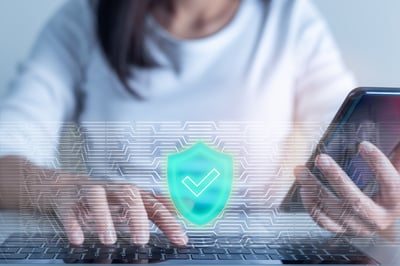This blog post shares highlights from our ADVANCE.AI Academy webinar: Introduction to eKYC. Missed the webinar? Catch up on the highlights below or watch it on-demand now.
KYC or Know Your Customer, at the heart of it, is knowing who your potential customer is, plus understanding and assessing the different kinds of risks that's associated with whom you're getting into business with. And after that, accepting those risks, and monitoring them as you move along in a brand-customer relationship. That's the fundamental principle of knowing your customers.
It helps organisations answer important questions about the true identity of a potential customer, where the person is from, etc. Likewise, for individuals, verification checks help us know whom we may be passing our money to, what businesses are they engaged in, etc.
Why look at KYC? Because of a very real issue: solving the the problem of crime and preventing crime from potentially happening.
eKYC as the first frontier for crime prevention
Money laundering costs about the world about 2 to 5% of global GDP. Which means with every $100, $5 is probably part of a mundane laundering circle cycle at some point in time. When we talk about money laundering, there may be some faces that come to mind – Al Capone, Pablo Escobar and so forth. These famous or infamous folks who have been involved in financial crime in some way or another, have created a huge impact on both economies, environment as well as on a social level.
But money laundering isn't just about these notorious faces, different institutions such as banks and corporations have also been affected by financial crime, and major banks in the region have been heavily penalised for not upholding strong standards of anti-money laundering (AML) or KYC controls. Simply by being careless, or not having verification checks in place, one can facilitate illicit activities. Financial crime has a waterfall effect; it's not just the institutions that are suffering – government agencies, businesses large and small, as well as individuals – are also impacted.
 eKYC helps organisations better understand the true identity of a potential customer
eKYC helps organisations better understand the true identity of a potential customer
So rather than due diligence by one party, eKYC should really be a shared responsibility, a community effort. Conversations around eKYC and verification need to be had often. And if you haven't had that conversation yet? It's definitely better to have it sooner rather than later.
The importance of eKYC with growing digital activity
How did eKYC come about? We'll need to go all the way back to the beginning of internet. As the internet starts to get widely adopted, we see the rise of web pages, emergence of the .com era, the start of e-mails, banking services, e-commerce, innovative services and yes, online transactions.
As we go online more, the need for eKYC increased, and the curve grows exponentially with the explosion of the digital age. Then obviously, COVID changed everything. The pandemic has had a social impact on all of us, but at the same time, it has positively influenced our digital journey. The key takeaway here is: it can happen at any point in time, it may happen again, soon. Our digital journey accelerated in a way that we have never seen before. We have sped up our speed of development by an average of three years, increasing our digital adoption, transformation, accelerating a number of online transactions, and in many cases, you will start to see the emergence of more companies moving into innovative financial technologies, e-currency, wallets, and so forth.
On the flip side, cyber financial crime is growing too – driven by pretty much the same digital growth factors. You might recall receiving more phishing mails and calls recently as compared to before COVID. This effort in KYC, in fighting crime, is an ever-evolving journey – it's not a sprint but a marathon – but a necessary one all of us must partake.
Adopting certain processes and controls to mitigate immediate risk is good start, but it'd be lacking foresight to not consider your next steps, especially in today's hyper digital world.
In a very simplified view, eKYC involves 3 main steps:
-
Input + controls
-
Data input via application data and here is where ID Optical Character Recognition (OCR) and Image Quality Assessment (IQA) can help with accurate capture
-
Proof of presence, for example, via ADVANCE.AI's Liveness Detection and VKYC technologies
-
Early fraud prevention via Face Comparison and Device Fingerprint
-
-
Verify + identify
-
Background check via ID verification through internal and external sources, and see if the person is on any high-risk list
-
Credit bureau check and income verification, etc
-
Additional alternative non-bank data such as telco and e-commerce data
-
-
Decide + monitor
-
Scoring by processing information to create application scores, alternative scores, etc.
-
Decisioning, onboarding followed by possibly monitoring transactions for possible fraud or high-risk individuals
-
Many organisations are leveraging partners such as ADVANCE.AI to implement their eKYC processes and for good reason too. Building an entire solution on one's own may offer full control and customisation but can be a resource-heavy investment. Moreover, leveraging partners means organisations can quickly access ready, proven solutions that not only allow for fast deployment, but more time to focus on other organisational focuses such as product innovation, customer experience and expanding your product offerings.
Learn more about our webinars at ADVANCE.AI Academy, or jump right in to a complimentary demo and consultation session with our experts to get started on your eKYC journey.






